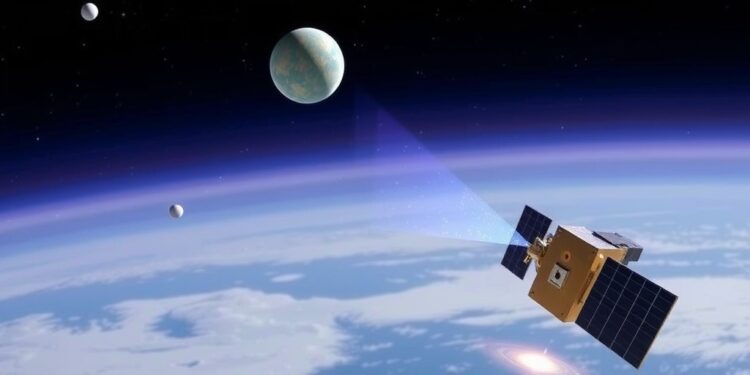A promising initiative led by researchers at the University of Alaska Fairbanks (UAF) is set to revolutionize the field of space debris detection. Space debris, comprising defunct satellites, spent rocket stages, and fragments from previous collisions, poses a significant risk to operational spacecraft in low-Earth orbit. Currently, objects larger than 1 centimeter, approximately half an inch, remain undetectable from terrestrial observation systems, yet they possess the potential to inflict substantial damage to active satellites.
This endeavor, aimed at developing a specialized satellite equipped with advanced instruments, focuses primarily on detecting smaller pieces of orbital debris. The implications are far-reaching, particularly for the safety and sustainability of communication satellites that are integral to modern infrastructure. With the advent of this technology, future satellites could be empowered with the means to navigate around hazardous space debris, thus ensuring uninterrupted communication and operation in orbit.
Space debris travels at astonishing speeds, reaching approximately 17,500 miles per hour. At this velocity, a mere 1-centimeter object can generate an impact energy comparable to that of a hand grenade. The threat this presents is profound, as even small debris can compromise the integrity of entire spacecraft. Researchers emphasize that the consequences of collisions in orbit can be catastrophic, leading to mission failures and the creation of even more debris, further exacerbating the issue.
The scientific team led by UAF’s Geophysical Institute research professor Paul Bernhardt is pioneering a novel approach to detect these elusive debris objects. Alongside their collaborators from the University of Calgary in Canada, they have devised a method based on the interaction between orbiting objects and naturally occurring plasma disturbances, known as striations, that are aligned along Earth’s magnetic field lines. Plasma, a state of matter consisting of free electrons and ions, plays a critical role in the proposed detection mechanism.
Bernhardt’s methodology involves the generation of electromagnetic waves as satellites traverse through these plasma regions. The research team has engineered specialized sensors capable of simultaneously measuring electric and magnetic wave fields. By analyzing the signals emitted from the debris, these sensors can determine the distance and trajectory of space objects, marshalling data critical for avoiding potential collisions.
The instrument suite being developed will be housed on a satellite named the Space Debris Hunter, which is designed solely for the purpose of tracking debris too small for ground-based detection systems. This dedicated reconnaissance platform will represent a significant leap in the quest for space safety, providing the insights necessary for real-time collision avoidance maneuvers.
As stated by Bernhardt, acquiring consistent measurements will ensure the future trajectory of space debris can be predicted effectively. This new scientific frontier represents not only a technological advancement but also a paradigm shift in how we approach space debris management. The anticipated results could enable operators to preemptively steer satellites away from potential collision paths, significantly reducing the risk of catastrophic impacts in the increasingly crowded orbital environment.
The urgent need for enhanced debris detection capabilities is underscored by the staggering estimate from the U.S. debris-tracking program, which identifies more than 100 million objects larger than 1 millimeter in orbit. Alarmingly, less than 1 percent of these pose a serious risk to active missions and are currently being monitored. This stark reality highlights the critical importance of developing methods to track smaller pieces of debris, as the frequency of collision avoidance and the need for evasive actions continually increase.
The findings of this groundbreaking research were detailed in a paper published in the journal Physics of Plasmas, which offers a comprehensive account of the team’s methodologies and discoveries. Featuring as lead author Bengt Eliasson from the University of Strathclyde, the paper elucidates the generation of specific electromagnetic waves as satellite instruments navigate through ionospheric irregularities.
The convergence of efforts, spurred by support from the Office of the Director of National Intelligence, is fostering collaborative endeavors with contractors such as Blue Halo. This partnership aims to bolster the United States’ capacity for identifying and tracking space debris through the Intelligence Advanced Research Projects Activity’s (IARPA) Space Debris Identification and Tracking program, reflecting the heightened focus on this pressing issue.
As satellite operators currently face countless collision avoidance actions each year—20,000 annually for systems like Starlink—the stakes are higher than ever. The culmination of these efforts promises not only to enhance detection capabilities but also to pave the way for innovative new approaches to combat the challenges posed by an ever-growing orbital debris field. As research continues, the route to safeguarding our satellites and ensuring the longevity of space operations will increasingly rely on scientific advancements in debris tracking and avoidance strategies.
Thus, as the Space Debris Hunter embarks on its mission, it symbolizes a hope for a more secure future in Earth’s orbit, where satellites operate safely amid a sea of orbital debris. The research community firmly believes that through dedicated exploration and innovation, solutions to one of space exploration’s most daunting challenges can be found, ensuring the preservation of a sustainable space environment for generations to come.
Subject of Research: Space debris detection and tracking
Article Title: The generation of whistler, lower hybrid, and magnetosonic waves by satellites passing through ionospheric magnetic field aligned irregularities
News Publication Date: February 8, 2025
Web References: Physics of Plasmas
References: DOI: 10.1063/5.0225399
Image Credits: Not provided.
Keywords
Space debris, satellite tracking, electromagnetic waves, orbit safety, collision avoidance, plasma disturbances, space research, University of Alaska Fairbanks.




